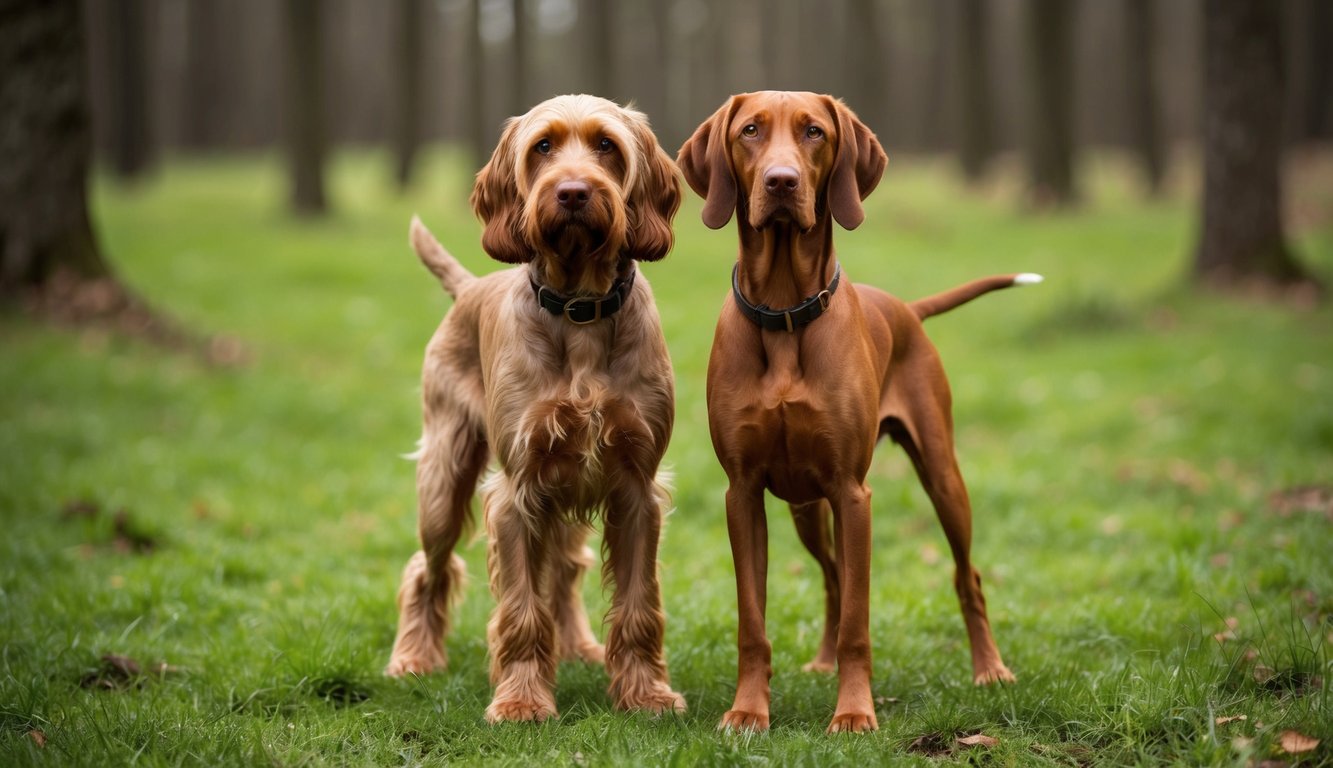The Wirehaired Pointing Griffon and Wirehaired Vizsla have unique histories. Both breeds were developed for hunting, but in different countries and time periods. Let’s take a look at these two dog breeds.
If you’re still on the market to buy one of these two breeds, PuppySpot currently offers a $300 discount using the code PUPPY300, just click the banner below!
Physical Characteristics
Wirehaired Pointing Griffons and Wirehaired Vizslas have distinct physical traits that set them apart. Their size, weight, and coat characteristics are key factors in distinguishing these two breeds.
Size and Weight Comparison
- Wirehaired Pointing Griffons are medium-sized dogs. Males typically stand 22-24 inches tall at the shoulder. Females are slightly smaller at 20-22 inches. These dogs usually weigh between 50-70 pounds.
- Wirehaired Vizslas are also medium-sized but tend to be a bit larger. Males stand 23-25 inches tall, while females are 21-23 inches. They weigh between 45-65 pounds on average.
- Both breeds have a sturdy, athletic build suited for hunting and outdoor activities. Their size allows them to be agile in various terrains.
Coat and Coloring Distinctions
- Wirehaired Pointing Griffons have a distinctive rough, double coat. The outer coat is coarse and wiry, while the undercoat is soft and dense. Their coat colors range from steel gray to grizzle (gray and brown mix).
- Wirehaired Vizslas have a similar wire-haired coat, but it’s generally shorter and less dense. Their coat is always a solid golden-rust color, which is a defining feature of the breed.
- Both breeds have a weather-resistant coat that protects them in various conditions. The Griffon’s coat may require more grooming due to its density. Vizslas typically need less maintenance.
- Griffons often have a beard and eyebrows, giving them a distinctive expression. Vizslas have a cleaner facial profile with less facial hair.

Temperament and Personality
The Wirehaired Pointing Griffon and Wirehaired Vizsla have distinct personalities that shape their interactions with humans and other animals. Both breeds are known for their intelligence and loyalty, but they differ in some key traits.
Behavioral Traits of Wirehaired Pointing Griffon
Wirehaired Pointing Griffons are intelligent and independent dogs with a strong desire to please their owners. They learn tricks and commands easily, making them highly trainable. These dogs are affectionate and form strong bonds with their families.
You’ll find Griffons to be:
- Friendly and outgoing
- Protective of their family
- Excellent with children
- Adaptable to various living situations
Their hunting instincts are strong, so they may chase small animals. Early socialization helps them get along with other pets. Griffons need plenty of exercise and mental stimulation to stay happy and well-behaved.
Temperament Details of the Wirehaired Vizsla
Wirehaired Vizslas are medium-sized dogs with a golden-rust coat. They share many traits with their smooth-coated cousins but have some unique characteristics.
Key personality traits of Wirehaired Vizslas include:
- Gentle and affectionate nature
- High energy levels
- Strong desire for human companionship
- Excellent hunting instincts
These dogs are known as “velcro dogs” because they stick close to their owners. They’re friendly with strangers but may be shy at first. Vizslas are intelligent and eager to please, making them easy to train. You’ll need to provide plenty of exercise and mental challenges to keep your Wirehaired Vizsla happy. They excel in various dog sports and activities.
Health and Lifespan
Both the Wirehaired Pointing Griffon and Wirehaired Vizsla are generally healthy breeds. They share some common health issues but also have unique concerns. Their lifespans are similar, with proper care playing a key role in their longevity.
Common Health Issues in Both Breeds
- Hip dysplasia is a concern for both breeds. This condition can cause pain and mobility issues as the dogs age. Ear infections are another shared health problem, partly due to their floppy ears trapping moisture.
- Eye problems like entropion can affect both breeds. Regular check-ups with a vet can help catch these issues early. Both dogs may also develop skin allergies or sensitivities.
- Cancer is a risk for many dog breeds, including these two. Regular screenings and early detection are important for managing this threat.
Average Lifespan and Preventative Care
The Wirehaired Pointing Griffon has an average lifespan of 12-14 years, while the Wirehaired Vizsla typically lives 12-15 years. To help your dog reach these upper limits:
- Provide regular exercise
- Feed a balanced diet
- Schedule yearly vet check-ups
- Keep up with vaccinations
- Maintain dental hygiene
Early detection of health issues can greatly improve outcomes. Watch for changes in behavior, appetite, or energy levels. Grooming sessions are a good time to check for lumps, skin issues, or other abnormalities. Regular ear cleaning can help prevent infections in both breeds. Trim nails regularly to avoid discomfort and potential joint issues.
Grooming and Maintenance
Wirehaired Pointing Griffons and Wirehaired Vizslas have distinct grooming needs. Their coats require specific care to stay healthy and clean.
Coat Maintenance Requirements
- The Wirehaired Pointing Griffon’s coat needs regular attention. You should brush it weekly to remove dead hair and prevent matting. Their wiry outer coat and dense undercoat benefit from hand-stripping a few times a year.
- Wirehaired Vizslas have a shorter, easier-to-maintain coat. You can brush them once or twice a week to keep their coat in good condition. Both breeds need occasional baths, about every 2-3 months or when they get dirty.
- For both breeds, check and clean their ears regularly. Trim their nails every few weeks to prevent overgrowth.
Grooming Needs and Shedding Levels
- Wirehaired Pointing Griffons shed moderately. Their coat traps loose hair, so regular brushing helps control shedding. They’re not considered hypoallergenic, but their coat may trap some dander.
- Wirehaired Vizslas shed less and are often more allergy-friendly. Their coat doesn’t need as much upkeep, but regular brushing still helps minimize shedding.
- Both breeds need their teeth brushed regularly. Professional grooming every few months can help maintain their coat and overall cleanliness.
- Remember to introduce grooming routines early to make the process easier for both you and your dog.
Training and Exercise Needs
Wirehaired Pointing Griffons and Wirehaired Vizslas have high energy levels and strong hunting instincts. They need plenty of exercise and consistent training to thrive as pets and working dogs.
Exercise Requirements for Healthy Living
Both breeds need lots of daily exercise. You should plan for at least 60-90 minutes of activity per day. This can include:
- Long walks or jogs
• Off-leash running in a fenced area
• Swimming
• Fetch games
These dogs excel at canine sports like agility, tracking, and hunt tests. Regular exercise helps prevent boredom and destructive behaviors. Without enough activity, they may become restless or anxious. Griffons have a slightly lower energy level than Vizslas. They may be content with moderate exercise some days. Vizslas typically need intense daily workouts to stay happy and healthy.
Training Approach and Behavior Management
- Both breeds are intelligent and eager to please. They respond well to positive reinforcement training methods. Use treats, praise, and play to reward good behavior.
- Start training early to manage their strong hunting instincts. Teach basic obedience commands like “sit,” “stay,” and “come.” Practice recall often, as both breeds may get distracted by scents or prey when off-leash.
- Socialization is key for these friendly but sometimes reserved dogs. Expose them to many people, animals, and situations as puppies. This builds confidence and prevents fearfulness.
- Focus on channeling their pointing and retrieving instincts into appropriate activities. Provide puzzle toys and scent games to keep their minds engaged. With proper training, these versatile dogs make excellent hunting companions and family pets.

Role in Hunting and Work
The Wirehaired Pointing Griffon and Wirehaired Vizsla are skilled hunting companions. They excel as gun dogs and have strong instincts for fieldwork.
Effectiveness as Gun Dogs
- Both breeds are versatile hunting dogs that can work in various terrains. You’ll find them equally comfortable on land and in water.
- The Wirehaired Pointing Griffon has a dense, wiry coat that protects it in rough conditions. It’s known for its pointing and retrieving skills. This breed excels at tracking and flushing game birds.
- Wirehaired Vizslas are adept at working in fields, forests, and water. Their wire coat helps them navigate thick brush. They have a strong pointing instinct and can retrieve game effectively.
- Both breeds have keen noses that help them locate game. They’re patient and steady, making them reliable hunting partners.
Instinctual Work Traits
These dogs have natural hunting instincts that make them valuable in the field. Their pointing behavior is innate, not taught.
Wirehaired Pointing Griffons are known for their:
- Strong prey drive
- Excellent scenting ability
- Eagerness to please their handlers
Wirehaired Vizslas display:
- High energy in the field
- Sharp focus on the task at hand
- Strong retrieving instincts
Both breeds can be trained to remove vermin if needed. Their versatility makes them useful for various hunting and work tasks. You’ll find these dogs are quick learners and respond well to training. Their desire to work closely with you makes them reliable hunting companions.
Compatibility with Families and Pets
Both the Wirehaired Pointing Griffon and Wirehaired Vizsla are known for their friendly nature and ability to fit well into family life. They each have unique traits that affect how they interact with children and other pets.
General Sociability and Family Integration
- The Wirehaired Pointing Griffon is extremely loyal to its human family. You’ll find this breed to be intelligent, loving, and affectionate. They adapt well to family life and are eager to please their owners.
- Wirehaired Vizslas are also family-friendly dogs. Their gentle nature makes them excellent companions. You can expect a Wirehaired Vizsla to bond closely with family members and seek attention and affection.
- Both breeds have high energy levels. You’ll need to provide them with daily exercise to keep them happy and well-behaved in the home.
Interaction with Children and Other Pets
- Wirehaired Pointing Griffons generally get along well with children. Their patient and gentle nature makes them good playmates for kids. You should still supervise interactions, especially with younger children.
- These dogs usually do well with other pets too. However, they may chase smaller animals due to their hunting instincts.
- Wirehaired Vizslas are also good with children. Their playful and energetic nature makes them great companions for active kids. They typically get along with other dogs and can be socialized to live with cats.
- For both breeds, early socialization is key. This helps ensure they grow up to be well-mannered around various people and animals.




